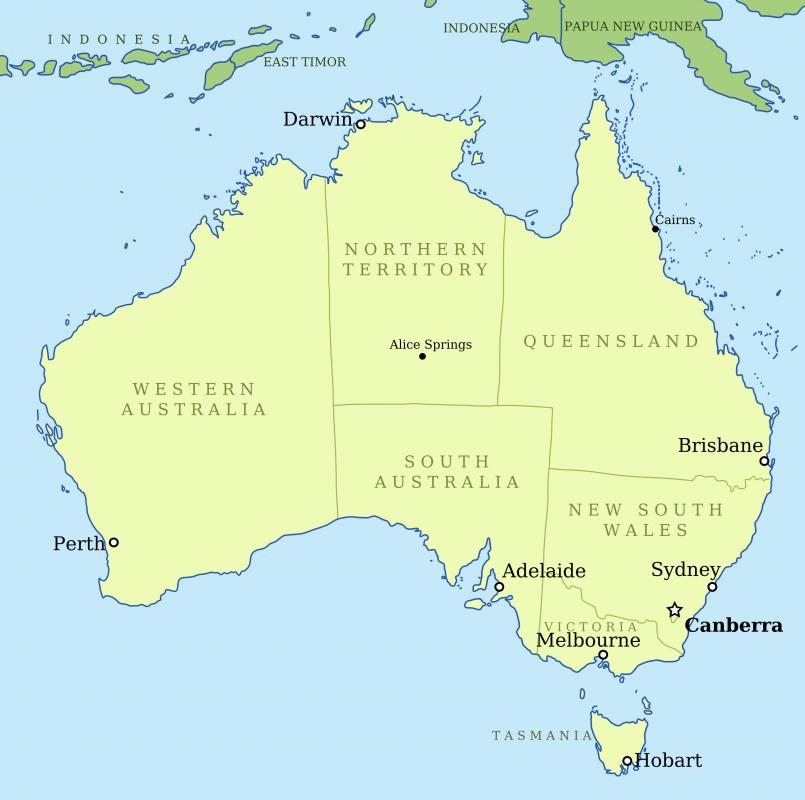At AllThingsNature, we're committed to delivering accurate, trustworthy information. Our expert-authored content is rigorously fact-checked and sourced from credible authorities. Discover how we uphold the highest standards in providing you with reliable knowledge.
What Is a Box Jellyfish?
A box jellyfish, scientific name Chironex fleckeri, is an extremely venomous invertebrate sea creature also known as the sea wasp or marine stinger. The sting from a box jellyfish is excruciatingly painful and in many cases can be fatal. It is found throughout the Indo-Pacific region, particularly in the waters off northern Australia, and the active season when it is most likely to sting can last from October to May. It has a bell or cube-like shape, a transparent shade of pale blue, and many tentacles. It is carnivorous, i.e., feeding on small crustaceans and fish, and typically lives for about one year.
Known as one of the most dangerous marine animals due to its venom, the box jellyfish is an invertebrate meaning it has no backbone. Its tentacles are covered in small stinging cells called nematocysts; when it stings, these cells often remain stuck to the victim. The sting causes pain which can be so severe it can leave the victim in shock and unable to move or swim. The venom also affects the heart, nerves, and skin that potentially causes cardiac arrest, lingering pain that lasts for weeks, and severe scarring and damage to the skin.

When an individual is stung by a box jellyfish, immediate medical attention is required. It's important to stop the action of the stinging cells before removing the tentacles by pouring vinegar over them for at least 30 seconds. Many cases also require antivenin, which is available in any hospital in areas where box jellyfish are found. The mildest cases can be treated with ice, painkillers, and antihistamine medications, but it's vital to be evaluated by a medical professional to determine appropriate treatment.

Native to the Indo-Pacific region, the box jellyfish is found throughout the area, especially in the tropical waters off northern Australia as well as Vietnam, the Philippines, and Papua New Guinea. They tend to stay in shallow coastal waters, or estuaries, creeks, and river mouths. The active "stinging season" typically extends from October until May, although stings have also been known to occur in June, July, and August.
The box jellyfish has a more defined shape than many other species, often similar to a cube or a bell with four sides. The tentacles occur in bunches of about 15 at each corner of the box-like body. It can grow as long as 10 feet (3 m) including the tentacles, and the body is transparent with a pale blue color. There are cluster groupings of eyes on each side that allow it to see, and it is also able to propel itself through the water rather than drifting.
As a carnivore, the box jellyfish feeds on small crustaceans and fish. It stings its prey to immobilize it before eating which prevents damage to the tentacles from a struggle. The typical lifespan is about a year, with the adults spawning in late summer and laying eggs called polyps which attach to rocks near river mouths. In the spring, they hatch into tiny jellyfish and are washed out to sea during the summer rainy season.
Frequently Asked Questions
What is a box jellyfish and how does it differ from other jellyfish?
A box jellyfish is a highly venomous marine animal known for its cube-shaped bell. Unlike other jellyfish, box jellyfish possess a more developed nervous system allowing for better navigation. They have clusters of eyes on each side of their bell, contributing to their advanced maneuverability in comparison to their more passive relatives.
Where can you typically find box jellyfish?
Box jellyfish are predominantly found in the warm coastal waters of the Pacific and Indian oceans, with a high concentration in the waters off Northern Australia and throughout Southeast Asia. They tend to inhabit mangroves and shallow waters, often lurking near the shore during certain seasons.
How dangerous is the venom of a box jellyfish?
The venom of a box jellyfish is among the most potent in the world. It can cause severe pain, paralysis, and even death within minutes. According to research, the sting of the Chironex fleckeri, a species of box jellyfish, has caused over 60 fatalities in Australia since records began in the 1880s.
What should you do if stung by a box jellyfish?
If stung by a box jellyfish, it's crucial to seek immediate medical attention. Rinse the area with vinegar to neutralize the venom, remove tentacles with tweezers, and apply a hot pack to alleviate pain. Do not rub the sting area or rinse with fresh water, as this can exacerbate venom release.
Can box jellyfish be kept in aquariums?
Keeping box jellyfish in home aquariums is not recommended due to their complex care requirements and the danger they pose. Specialized public aquariums with the necessary expertise and equipment can house certain species, ensuring a safe environment for both the jellyfish and human handlers.
Are there any predators of the box jellyfish?
Despite their potent venom, box jellyfish do have natural predators. Sea turtles, particularly the hawksbill and the leatherback, are known to feed on them, seemingly unaffected by the jellyfish's venom. This predation plays a role in controlling box jellyfish populations in their natural habitats.
AS FEATURED ON:
AS FEATURED ON:












Discuss this Article
Post your comments